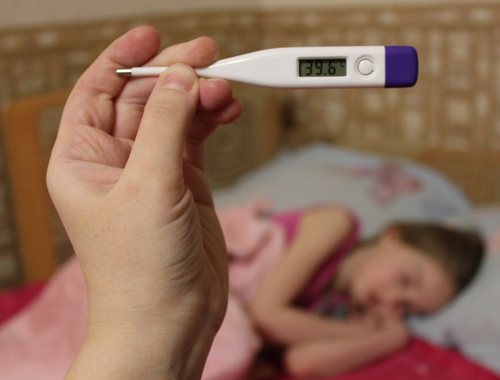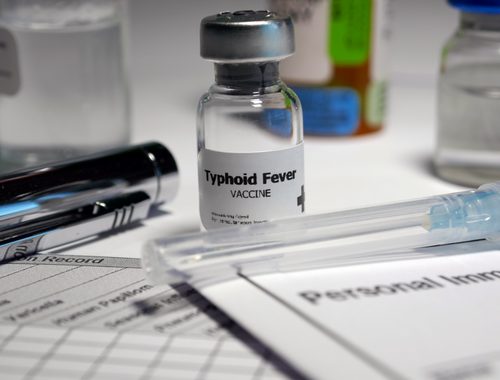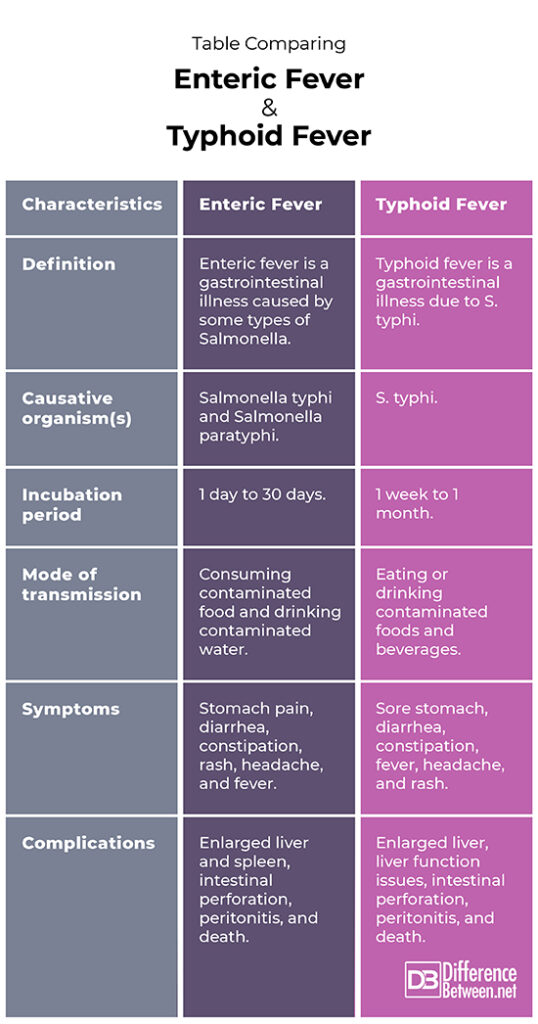Difference Between Enteric Fever and Typhoid Fever
Enteric fever describes illnesses like typhoid fever and paratyphoid fever. Typhoid fever is an infection with Salmonella typhi.

What is Enteric fever?
Definition:
Enteric fever is a term used to describe both paratyphoid fever and typhoid fever.
Causative pathogen(s):
Bacteria in the Salmonella genus cause enteric fever. This includes Salmonella typhi and Salmonella paratyphi types A, B or C.
Diagnosis:
Diagnosis is by stool or urine samples along with blood tests looking for the bacteria or evidence of the bacteria in the form of antibodies. Bacteria can be cultured and then identified to establish which type of enteric fever it is, whether typhoid or paratyphoid fever. The Widal test can show typhoid fever because it is a test for antibodies to that bacterium, but it does not work for paratyphoid fever.
Symptoms and prevalence:
The symptoms of enteric fever include a skin rash, headache, fever, painful stomach, diarrhea, and constipation. People with enteric fever develop a temperature of between 102oF and 104oF. Enteric fever is not that common in the United States, but about 400 to 500 cases are recorded each year. Travelers to countries where the illness is more common are at higher risk of infection.
Complications:
Complications of enteric fever can include an enlarged spleen and enlarged liver. There may also be problems related to how well the liver functions; a common complication of severe and untreated enteric fever is perforation of the intestine. The perforation can cause the infection to spread throughout the abdomen, causing peritonitis, and, ultimately death.
Treatment:
The treatment of enteric fever relies on antibiotics since these illnesses are caused by bacterial organisms. The most commonly used antibiotics include azithromycin, ceftriaxone, and gatifloxacin.

What is Typhoid fever?
Definition:
Typhoid fever is a gastrointestinal infection that is specifically caused by S. typhi bacteria.
Causative pathogen(s):
Salmonella typhi is the type of bacterium that is responsible for typhoid fever.This infection is more common in countries of Southeast Asia and in places where sanitation is ineffective, allowing the bacteria to flourish.
Diagnosis:
Diagnosis of typhoid fever can be made in a number of ways, including looking for the bacteria in urine or stool samples. Blood tests, namely the Widal test, can also show the presence of S. typhi antibodies. Microscope slides made from cultures can show the bacteria, which can then be identified.
Symptoms and prevalence:
The signs of typhoid fever include persistent high fever, sore stomach, constipation or diarrhea, and red spots that appear on the chest and abdomen. There may be issues with blood clotting, and anemia may also develop. Most cases (80%) of enteric fever in the U.S. are typhoid fever. It is the more common type of enteric fever in the country.
Complications:
A potential complication of typhoid fever is intestinal perforation. This can lead to peritonitis and death.
Treatment:
Antibiotics are used to kill the bacteria causing typhoid fever. Antibiotics that are usually used to treat people with typhoid fever include ciprofloxacin and ceftriaxone.
Difference between Enteric fever and Typhoid fever?
Definition
Enteric fever is a gastrointestinal illness caused by some types of Salmonella bacterial species. Typhoid fever is a gastrointestinal illness that is due to infection by S. typhi.
Causative organism(s)
Salmonella typhi and Salmonella paratyphi cause enteric fever. S. typhi causes typhoid fever.
Incubation period
The incubation period for enteric fever varies from 1 day to 1 month, depending on the pathogen involved. The incubation period for typhoid fever varies from 1 week to 1 month.
Mode of transmission
You can catch enteric fever by consuming contaminated food and drinking contaminated water. You can catch typhoid fever by eating and drinking contaminated food and drink.
Symptoms
Stomach pain, diarrhea, constipation, rash, headache, and fever are symptoms of enteric fever. Sore stomach, diarrhea, constipation, fever, headache, and rash are signs of typhoid fever.
Complications
Complications of enteric fever include an enlarged liver and enlarged spleen, intestinal perforation, peritonitis, and death. Complications of typhoid fever include an enlarged liver, liver function issues, intestinal perforation, peritonitis, and death.
Table comparing Enteric fever and Typhoid fever

Summary of Enteric fever Vs. Typhoid fever
- Enteric fever is a general term used to describe both paratyphoid fever and typhoid fever.
- Typhoid fever is a specific illness caused by infection with S. typhi.
- Enteric fever and typhoid fever can both result in dangerous complications such as intestinal perforation and peritonitis.
FAQ
What is the difference between typhoid and typhoid fever?
There is no difference between typhoid and typhoid fever. They refer to the same illness.
What is meant by enteric fever?
Enteric fever is a term used to describe the illness caused by S. paratyphi and S. typhi.
What are the types of enteric fever?
The two types of enteric fever are paratyphoid fever and typhoid fever; these are both illnesses caused by Salmonella bacteria.
What is the difference between Salmonella typhi and typhoid?
Salmonella typhi is the pathogenic bacteria that causes typhoid fever. Typhoid is another name for typhoid fever.
Which antibiotic is best for enteric fever?
Azithromycin, ceftriaxone, and gatifloxacin are the best antibiotics to use for treating enteric fever since it is due to bacterial infection.
Which test is done for enteric fever?
A blood test that looks for the bacteria is done for enteric fever; diagnosis can also be based on cultures from urine and stool samples.
- Difference Between Rumination and Regurgitation - June 13, 2024
- Difference Between Pyelectasis and Hydronephrosis - June 4, 2024
- Difference Between Cellulitis and Erysipelas - June 1, 2024
Search DifferenceBetween.net :
References :
[0]Bush, Larry M. and Maria T. Vazquez-Pertejo. “Typhoid fever”. Merckmanuals. Merck & Co., 2022, https://www.msdmanuals.com/professional/infectious-diseases/gram-negative-bacilli/typhoid-fever
[1]Bush, Larry M. and Maria T. Vazquez-Pertejo. “Typhoid fever”. Merckmanuals. Merck & Co., 2022, https://www.msdmanuals.com/professional/infectious-diseases/gram-negative-bacilli/typhoid-fever
[2]NICD. “Enteric fever.” Diseases A – Z. National Institutes for Communicable Diseases, 2022, https://www.nicd.ac.za/diseases-a-z-index/enteric-fever/
[3]Waddington, Claire S., Thomas C. Darton, and Andrew J. Pollard. "The challenge of enteric fever." Journal of Infection 68 (2014): S38-S50.
